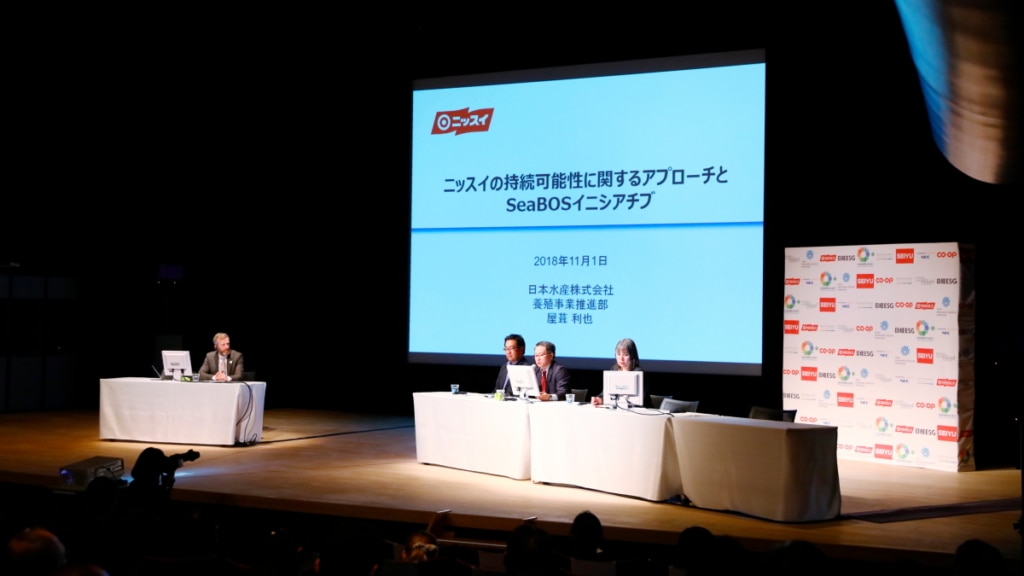
Tokyo Sustainable Seafood Symposium 2018 Report-4
On this fourth symposium report we will share about the three break-out sessions that took place in the Main Hall, including: an update from the global initiative Seafood Business for Ocean Stewardship (SeaBOS) that brings together some of the largest seafood companies; the growing possibility of collaboration between IoT technology and farmed seafood; and the importance of seafood to ESG investments.
M-1: A Vision and Commitment for the Future of Global Seafood Businesses
Henrik Österblom, Deputy science director, The Stockholm Resilience Centre
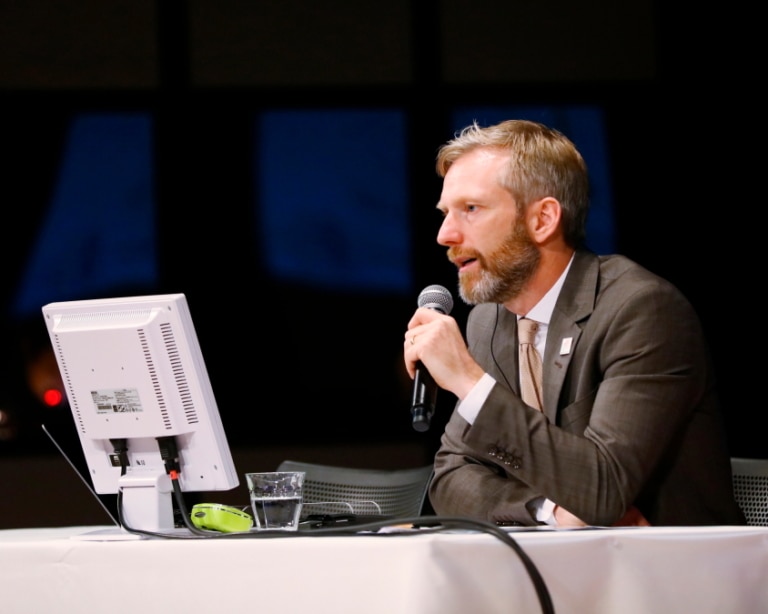
“The 10 companies that are involved in SeaBOS have the power to change the global seafood industry. In addition to being leaders in the seafood industry they can also lead in realization of the SDGs. To accelerate the speed of change, partnerships and collaborations among companies is imperative. The Japanese companies have illustrated that they intend to be faithful to their commitment. We look forward to future developments.” |
Toshiya Yabuki
General Manager, Aquaculture Business Promotion Department, Nippon Suisan Kaisha, Ltd.
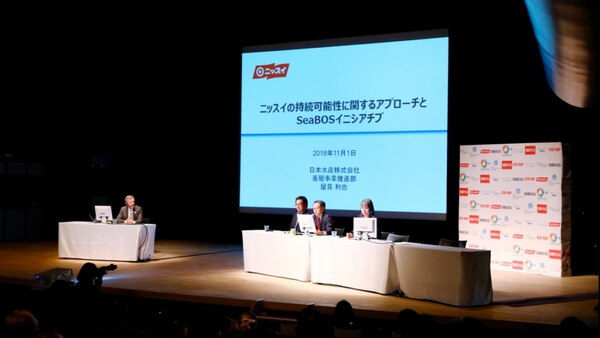
“In addition to participating in SeaBOS we have also actively participated in other international platforms such as GSSI and GDST. We spent a year and a half conducting stock assessments for 1.6 million tons of seafood spanning 450 species handled by Nissui Group. It turns out that 88% of seafood handled can be provided confidence. 30% of the products have already acquired certification. For the marine resources where assessments could not be completed due to lack of data, we would like to call for collaboration from various organizations to be able to gather necessary data. We will continue to work with the goal of ensuring sustainability for all marine products by 2030.” |
Hiroyuki Sato
Deputy Manager, Corporate Strategy Group, Corporate Planning Department, Maruha Nichiro Corporation
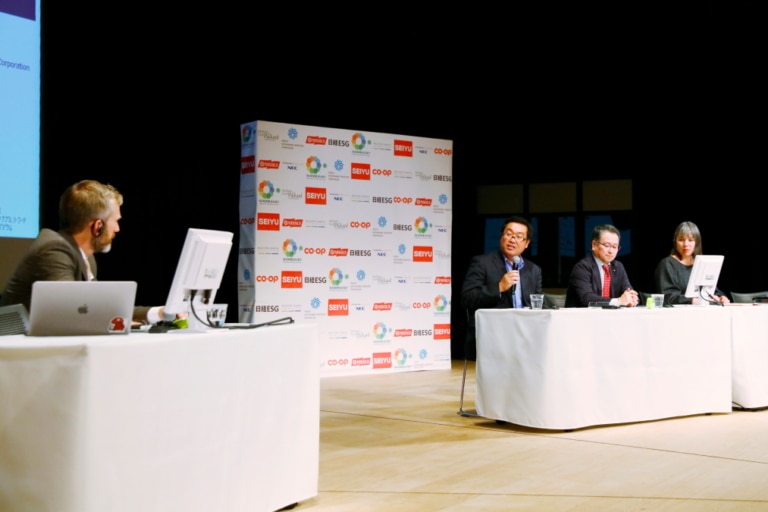
“Participating in SeaBOS led us to formulate our medium- and long-term corporate sustainability vision. In considering the impact we have on other companies as the biggest seafood company, we will strive to achieve the SDGs with our three pillar model of building economic value, social value, and environmental value. If the 10 companies participating in SeaBOS take the leadership and positively influence other companies I believe the initiative will be considered a success.” |
Teresa Ish
Program Officer, Environment Program, Walton Family Foundation
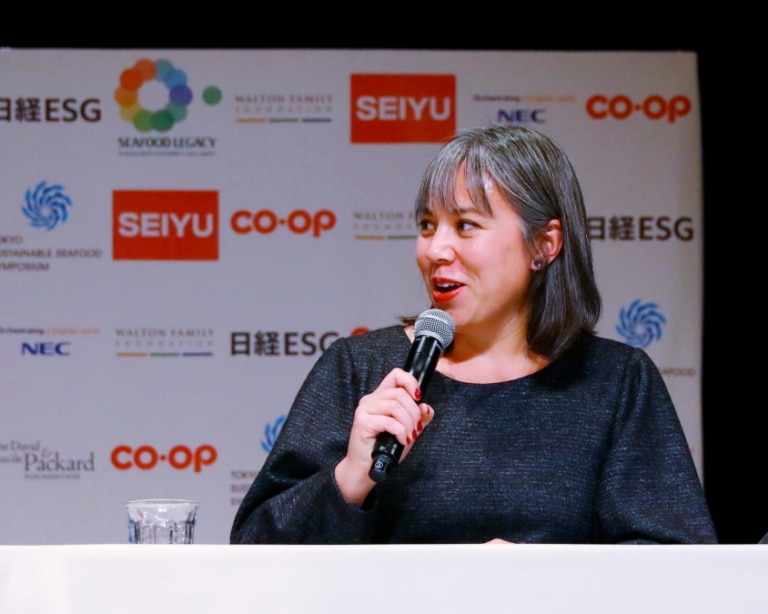
“SeaBOS is a revolutionary initiative in which competing companies choose to collaborate instead. These business leaders can influence the global seafood industry and fishery resource management policies by taking on this initiative. All of us should continue pursuing these matters until we reach a point where we can say that sustainability is not something special, but its expected for all the seafood we consume.” |
A-2: How IoT is Changing the Global Seafood Industry
Kaori Fujita
Senior Editor, Nikkei ESG / Producer, Nikkei ESG Economic Forum

“The communities that support seafood production are directly facing issues of an aging society, decreasing population and shrinking workforce. There is a ‘smart fishery’ movement to resolve these issues by incorporating AI and IoT to fishery operations. I hope this session can bring together seafood industry folks and visitors not involved in seafood.”
Keiichi Yamamoto
Chief Manager, ICT and Regional Revitalization Promotion Office, NTT DOCOMO, INC.

“We developed an application that upload ocean condition data measured by sensors to the cloud and can easily be accessed by fishermen. This eliminates the labor of personally checking ocean conditions, and in the case of seaweed producers the production volume and product quality improved using this system. We believe that being able to see things that were once not visible leads to new discoveries and innovation.” |
Masayoshi Fukushima
IoT Business Development Division, Local Development Support Office, Manager, KDDI CORPORATION
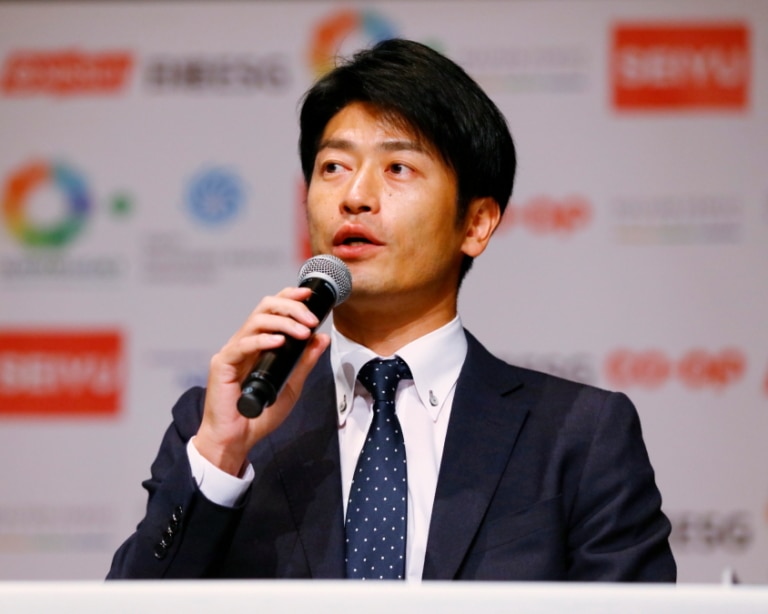
“We are collaborating with producers and universities to develop new technologies such as a system to estimate fish quantity inside set nets, a system to determine causational relationships between mackerel feed records and environmental measurements, and a method to implement counter-mesasures to red tide in bluefin tuna farms. As a telecommunication company we would like to contribute to the cost side of this movement by continuing to improve on these technologies.” |
Ken Fujiwara
Chief Executive Officer, UMITRON

“Considering that the potential area for seafood farms are said to be 100 times the current seafood consumption amount, the aquaculture industry is the most important sector of the seafood industry of this century. As we are developing a management analysis tool to optimize feeding, we feel that IoT technology and aquaculture technology are highly compatible since aquacultures require combination of data and management like large scale efficiency and decentralized management. IT and IoT technology are particularly useful in reducing costs, as well. In the future we would also like to build a insurance data service for aquacultures.” |
Mamiko Hayasaka
Manager, Digital Platform Division, NEC Corporation
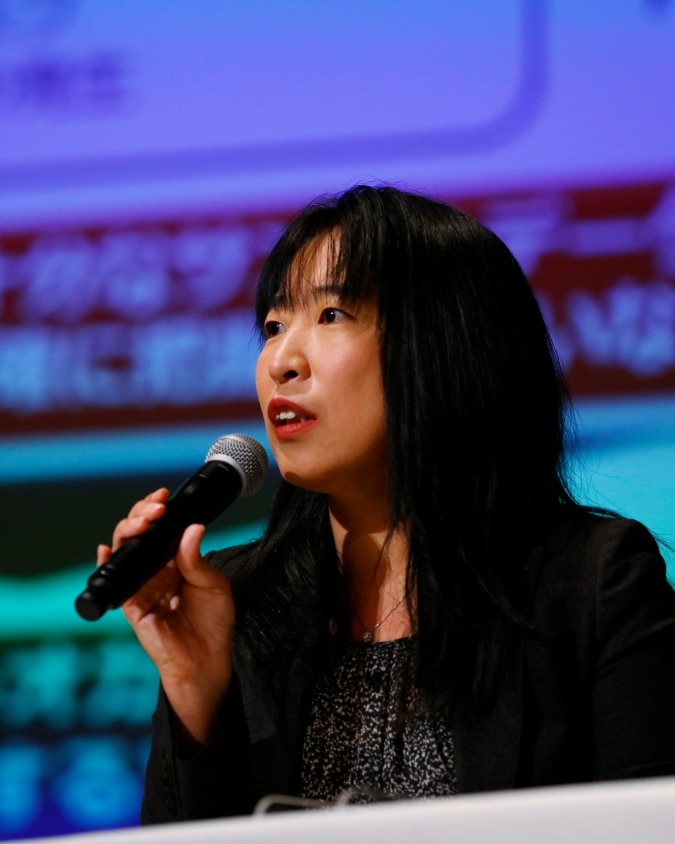
“Measurements of fish farms are currently conducted one fish at a time by hand, leading to large margins of error and small sample sizes. As a result, it was difficult to accurately estimate the total weight of fish — which are important during shipment — inside the cages. Therefore, NEC developed a solution that make it possible to automatically measure the size of farmed fish using stereo camera imaging. It is now possible to accurately measure fish without any damage to their bodies. In the future we would like to gather more data and contribute to the further development and sophistication of the aquaculture industry.” |
Aritsune Kawabe
Board Director and General Manager, Satellite Information Service Department, IHI Jet Service Co.,Ltd.

“We conduct our business using AIS Vessel Tracking data service provided by Canadian company exactEarth Ltd. Using this system has allowed us to track small scale fishing vessels in real time and also input catch information directly into the data message. Furthermore, we can improve traceability from fishing ground to plate by combining blockchain technology. The higher the traceability, the higher the value of the fish. Although the price may be higher, I expect that purchasing safer seafood will stabilize fishermen income and lead to an increase in the number of successors.” |
M-3: Potential of ESG Investment in the Seafood Industry
Kaori Fujita
Senior Editor, Nikkei ESG / Producer, Nikkei ESG Economic Forum

“According to Carbon Disclosure Project (CDP), a United Kingdom NGO that works to disclose environmental impacts such as carbon dioxide emission of major corporations, state that the focus is moving from climate change to water issues, then forest issues, followed by fish. The attention of ESG investors are beginning to shift from just climate change to natural capital as well. I hope this discussion will be followed by more exchanges of opinions and building of multi-stakeholder Living Lab environments between companies and investors.” |
Mariko Kawaguchi
Chief Researcher, Daiwa Institute of Research Ltd.
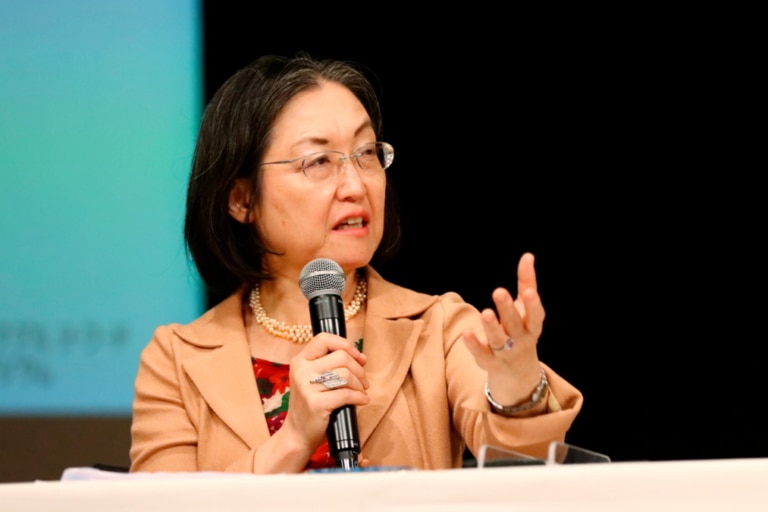
“What ESG investors are requesting from companies are information disclosure, comprehensive company information that have high materiality, and clarifying what takes place throughout the entire supply chain. According to a report on companies with overfishing risks issued by UK not-for-profit company Fish Tracker Initiative, 40 Japanese companies are included in the list of 228 companies. In other words, Japanese companies will be impacted the most. Japanese investors are beginning to realize that 30% of marine resources are overfished, and, therefore, highly risky. Once companies determine that information disclosure is important from a business perspective, they should immediately declare so and execute. It is necessary for Japanese companies to follow that by changing to a style that solidifies that process in order not to be left behind.” |
Takeshi Mizuguchi
Professor, the Faculty of Economics, Takasaki City University of Economics
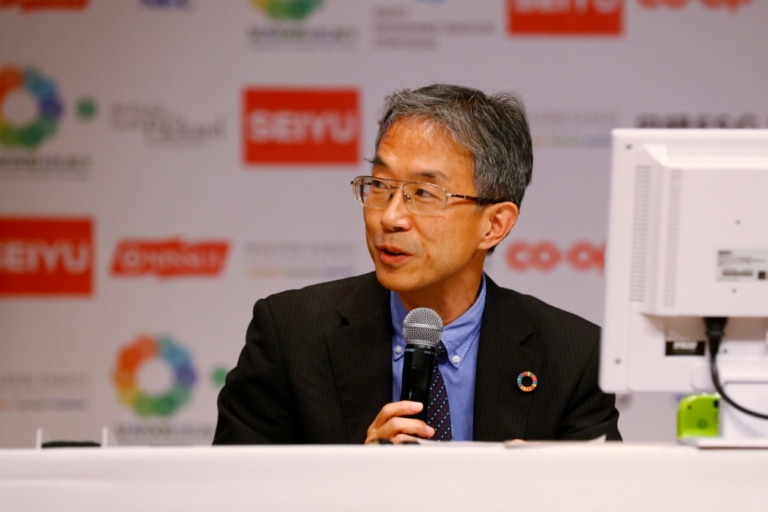
“I think there are two schools of thought behind ESG investment. The first is that ESG factors are considered as risks to companies, and the other that protecting sustainability of Earth is beneficial to investors. Risks in seafood include overfishing. In aquacultures overfishing of preyfish and use of antibiotics come to mind. In overseas supermarkets there is a movement to disclose information such as species, catch location and numbers of fishing grounds. The focus of investors will shift to supermarkets, food service industry, food companies and the entire supply chain and will certainly affect unlisted seafood companies as well.” |
Shinya Yamamoto
Director, Managing Executive Officer, and CFO, Nippon Suisan Kaisha, Ltd.

“At the time when we adopted sustainability into our mid- and long-term corporate plans the feeling was it would be wasteful cost-wise. However, we were encouraged to adopt it after the risks of not doing so was pointed out by an Outside Director, growing interest regarding tuna issues from the general public and media, and the support from regional presidents that are expanding their business overseas. We are currently working toward meeting SDGs, re-evaluating what are materialities, and also participating in SeaBOS. Although we still need to organize the information to disclose publicly, we would like to be able to openly disclose details regarding our activities in a timely manner.” |
Yasunobu Hasegawa
General Manager, Direct Communication Group, CSR Management Public Communications Dept., Ajinomoto Co., Inc.

“It is necessary for us to make non-financial KPIs numerical in order to have discussions with investors. If possible, it is ideal to evaluate these in monetary values. With that in mind, we converted all product life cycles, CO2 emissions and environmental impacts to water that are related to all divisions in US dollars. As a result, it became possible to explain the impact to natural environments, the social values that we are able to create, and impact of economic values to investors in a tangible way using monetary terms. We think that this system can be used to evaluate everything, including social improvement, happiness and human health.” |





